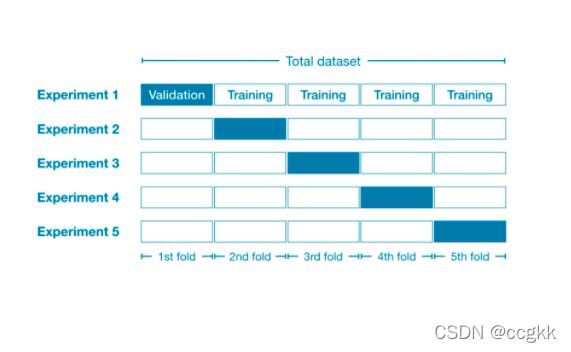机器学习之模型选择与调优
一、交叉验证
什么是交叉验证?
将拿到的训练数据分为训练和验证集。例如将训练数据分成4份,其中一份作为验证集。然后经过4组的测试,每次都更换不同的验证集,即得到4组模型的结果,取平均值作为最终结果,并称为4折交叉验证。
为什么需要交叉验证?
为了让被评估的模型更加准确可信
二、超参数搜索-网格搜索(Grid Search)
什么是参数搜索?
通常情况下,有很多参数是需要手动指定的(如KNN中的K值),这种叫做超参数。但是手中过程繁杂,所以需要对模型预设几种超参数组合。每种参数组合都采用交叉验证的方式来进行评估。最后选出最优参数组合建立模型。
| K值 | K=3 | k=5 | K=7 |
|---|---|---|---|
| 模型 | 模型1 | 模型2 | 模型3 |
三、模型选择与调优API
sklearn.model_selection.GriSearchCV(estimator,param_grid=None,cv=None)
- 对估计器的指定参数进行详尽搜索
- estimator:估计器对象
- param_grid:估计其参数,一般使用字典{“n_neighbors”:[1,3,5]}
- cv:指定几折交叉验证
- fit():输入训练数据
- score():准确率
- 结果分析:
最佳参数:best_params_
最佳结果:best_score_
最佳估计器:best_estimator_
交叉验证结果:cv_results_
四、代码实例
这里以使用KNN对莺尾花分类的案例进行调优,参考机器学习之K-近邻算法(KNN),调优后的代码见如下图所示
from sklearn.datasets import load_iris
from sklearn.model_selection import train_test_split
from sklearn.preprocessing import StandardScaler
from sklearn.neighbors import KNeighborsClassifier
from sklearn.model_selection import GridSearchCV
def knn_iris():
"""
用KNN算法对莺尾花进行分类
:return:
"""
# 1)获取数据
iris = load_iris()
# 2)数据划分
x_train,x_test,y_train,y_test = train_test_split(iris.data,iris.target,random_state=6)
# 3)特征工程(标准化)
transfer = StandardScaler()
x_train = transfer.fit_transform(x_train)
x_test = transfer.transform(x_test) # 上一步的fit已经计算出来了mean和std,在对x_test进行归一化的时候必须使用和x_train相同的mean和std,故这里只能transform
# 4)KNN预估器流程
estimator = KNeighborsClassifier()
# 加如网格搜索和交叉验证
#参数准备
param_dic = {"n_neighbor":[1, 3, 5, 7, 9, 11]}
estimator = GridSearchCV(estimator,param_grid=param_dic,cv=10)
estimator.fit(x_train,y_train)
# 5)模型评估
"""评估方法1:直接比对真实值和预测值"""
y_predict = estimator.predict(x_test)
print("y_predict:\n",y_predict)
print("直接比对真实值和预测值:\n",y_test == y_predict)
"""评估方法2:计算准确率"""
score = estimator.score(x_test,y_test)# 相当于计算了预估器的准确率,因为这里本来是完全一致的
print("准确率:\n",score)
# 最佳参数:best_params_
print("最佳参数\n",estimator.best_params_)
# 最佳结果:best_score_
print("最佳结果\n", estimator.best_score_)
# 最佳估计器:best_estimator_
print("最佳估计器\n", estimator.best_estimator_)
# 交叉验证结果:cv_results_
print("交叉验证结果\n", estimator.cv_results_)
return
if __name__ == '__main__':
knn_iris()
如果报错Invalid parameter xxx for estimator xxx. Check the list of available parameters with xxx
报错原因很明显,是你的estimator的参数不对,比如我给KNeighborsClassifier()了一个参数n_neighbor,但是其实KNeighborsClassifier()的参数是n_neighbors,建议你检查一哈参数是否正确!尤其是针对机器学习中的超参数搜寻的时候,所给字典里面的字段一定要正确!
如下面错误代码
param_dic = {"n_neighbor":[1, 3, 5, 7, 9, 11]}
estimator = GridSearchCV(estimator,param_grid=param_dic,cv=10)
estimator.fit(x_train,y_train)
正确代码应该如下
param_dic = {"n_neighbors":[1, 3, 5, 7, 9, 11]}
estimator = GridSearchCV(estimator,param_grid=param_dic,cv=10)
estimator.fit(x_train,y_train)
完整报错信息
ValueError: Invalid parameter n_neighbor for estimator KNeighborsClassifier(). Check the list of available parameters with `estimator.get_params().keys()`.
修改即可正常运行!!!!
